Religious architecture in Novi Sad is very diverse. Majority of the believers in Novi Sad are from Serbian Orthodox Church, while others are from Roman Catholic Church, many Protestant churches, and Jewish community. Stari Grad is the place with the majority of churches and temples, and they were all built in the 18th and 19th century.
The oldest religious building in the city was Orthodox church dedicated to Saint John. This church was built in 1700, but was burned in the 1848–49 revolution. It was rebuilt in 1853, but was razed in 1921.
Orthodox churches
The main Orthodox church in the city is The Orthodox Cathedral of Saint George (Saborna Crkva svetog Đorđa), built in 1742, it is next to the Bishop's Palace, the seat of the Serbian Orthodox Eparchy of Bačka. In city centre there are also the Church of Holy Dormition (Uspenska crkva), built in 1736, Almaš Church (Almaška crkva) in Almaški Kraj, built in 1797 and Russian Orthodox Church of St. Nicholas (Nikolajevska crkva), built in 1730 and rebuilt in 1849.[1] There is also Church of Presentation (Vavedenjska crkva) in Petrovaradin, as well as an Orthodox church in Sremska Kamenica, built in 1737–1758.
In the 1990s, at end of the state socialist period in Serbia, numerous new Serbian Orthodox churches were built in Novi Sad's neighbourhoods: in Klisa, Telep, Bistrica, Detelinara, Petrovaradin, Paragovo, and Veternik. These new churches are all built in Neo-Byzantine architecture, which is more Balkanic architecture and very different from the older Orthodox churches in the city, which are of a more Central Europe-type architecture.
Kovilj Monastery is the only Orthodox monastery in the municipal area of Novi Sad. It is located near the village of Kovilj. It was reconstructed in 1705–07 and according to the legend, the monastery was founded by the first Serb archbishop Saint Sava in the 13th century.
 Almaš Orthodox Church
Almaš Orthodox Church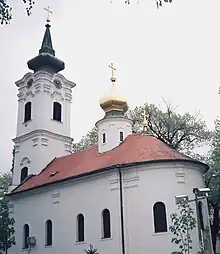 Orthodox Church of St. Nicholas (Nikolajevska crkva)
Orthodox Church of St. Nicholas (Nikolajevska crkva) Orthodox Church of Holy Dormition (Uspenska crkva)
Orthodox Church of Holy Dormition (Uspenska crkva) Orthodox Church of Saints Cyril and Methodius (Hram Svetih Ćirila i Metodija) in Telep
Orthodox Church of Saints Cyril and Methodius (Hram Svetih Ćirila i Metodija) in Telep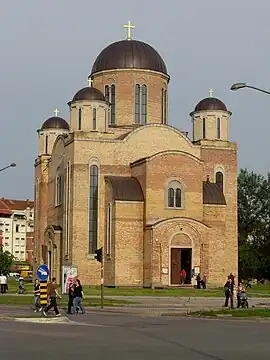 Orthodox Church of Translation of the relics of St Sava (Hram Prenosa moštiju Svetog Save) in Bistrica (under construction)
Orthodox Church of Translation of the relics of St Sava (Hram Prenosa moštiju Svetog Save) in Bistrica (under construction) Wooden Orthodox Church in Slana Bara
Wooden Orthodox Church in Slana Bara Orthodox Church of the Ascension of Our Lord (Hram Vaznesenja Gospodnjeg) in Slana Bara
Orthodox Church of the Ascension of Our Lord (Hram Vaznesenja Gospodnjeg) in Slana Bara Orthodox Church of Saint Apostles Peter and Paul (Kapela Svetih apostola Petra i Pavla) in Petrovaradin
Orthodox Church of Saint Apostles Peter and Paul (Kapela Svetih apostola Petra i Pavla) in Petrovaradin Orthodox Church of the Nativity of the Holy Virgin (Hram Rođenja Bogorodice) in Sremska Kamenica
Orthodox Church of the Nativity of the Holy Virgin (Hram Rođenja Bogorodice) in Sremska Kamenica Wooden Orthodox Church of Saint Petka (Crkva Svete Petke) in Petrovaradin
Wooden Orthodox Church of Saint Petka (Crkva Svete Petke) in Petrovaradin Orthodox Church of Saint George (Crkva Svetog Georgija) in Petrovaradin
Orthodox Church of Saint George (Crkva Svetog Georgija) in Petrovaradin Orthodox Church of the Holy Great Martyr Marina (Hram Svete velikomučenice Marine) in Pragovo
Orthodox Church of the Holy Great Martyr Marina (Hram Svete velikomučenice Marine) in Pragovo
Roman Catholic churches
Although Roman Catholic churches and worshippers are a minority in the city, for historical reasons, The Name of Mary Church (Crkva imena Marijinog) dominates city centre and it is one of the most recognised structures in Novi Sad. Built in Gothic Revival architecture, in 1895 on the site of an older church, which was burnt down, it is the tallest temple in the Bačka region. There are also two more Roman Catholic churches in the city, one in Telep and one in Grbavica (in Futoška street). There are also three Catholic churches in Petrovaradin and one in Sremska Kamenica (built in 1746), as well as a Franciscan monastery in Petrovaradin (1701–1714). Tekije Church in Petrovaradin, built in 1881, is used by all 3 Christian communities in the city: Orthodox, Protestant, and Catholic. There was also one Armenian church dedicated to St. Gregory the Illuminator, which was built in 1746, destroyed during bombardment in 1849, and then rebuild in 1872 with funds of Serbian philanthrope Marija Trandafil. This church was finally demolished in 1963 to make way for new boulevard.
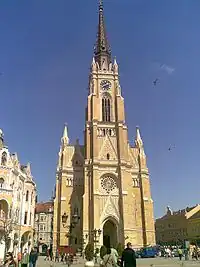
 Saint George church in Petrovaradin
Saint George church in Petrovaradin Saint Elizabeth Catholic Church in Telep
Saint Elizabeth Catholic Church in Telep The Our Lady of Snow ecumenic Church in Petrovaradin
The Our Lady of Snow ecumenic Church in Petrovaradin
Protestant churches
Rotkvarija neighborhood is home to the Slovak Lutheran church, built in 1886, conducting services predominantly in Slovak (occasionally in Serbian and German) and two Reformist churches, on in city Center, built in 1865, and another one in Telep, both having services in Hungarian. There are also many smaller temples of Baptist, Methodist, Adventist, Pentecostal and other Protestant communities. In most Protestant churches in Novi Sad, services are in Serbian.
 Slovak Evangelical A.V. (Lutheran) Church in Novi Sad
Slovak Evangelical A.V. (Lutheran) Church in Novi Sad Slovak Evangelical A.V. (Lutheran) in Kisač
Slovak Evangelical A.V. (Lutheran) in Kisač The Calvinist (Hungarian) church in Telep
The Calvinist (Hungarian) church in Telep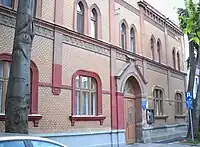 Evangelical Methodist Church
Evangelical Methodist Church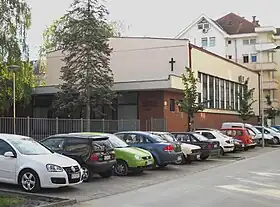 Christian Baptist Church
Christian Baptist Church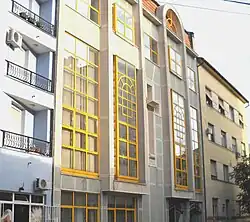 Christian Adventist Church
Christian Adventist Church Adventist prayer house
Adventist prayer house Adventist gymnasium "Živorad Janković"
Adventist gymnasium "Živorad Janković" Prayer House of Nazarene Christian Community
Prayer House of Nazarene Christian Community Jehovah's Witnesses prayer hall
Jehovah's Witnesses prayer hall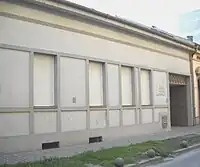 Protestant Evangelic Church
Protestant Evangelic Church Religious building of Protestant Christian Community
Religious building of Protestant Christian Community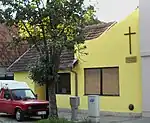 Spiritual Church of Christ
Spiritual Church of Christ
Greek Catholic church
Greek Catholic church, built in 1822 and used by Rusyn ethnic community, is situated in Stari Grad.
 Saint Peter and Paul Uniate (Rusyn) church
Saint Peter and Paul Uniate (Rusyn) church
Jewish and Muslim religious buildings
The Novi Sad Synagogue was built in 1905 in Art Nouveau architecture. Today, the temple is not used for religious ceremonies, but it is one of the most important cultural institutions in the city. There is also a mosque located in Futoška street.

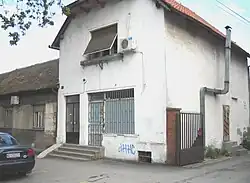 Masjid of Islamic Religious Community
Masjid of Islamic Religious Community
Latter-day Saints
 The Church of Jesus Christ of Latter-day Saints (LDS Church)
The Church of Jesus Christ of Latter-day Saints (LDS Church)
Jehovah's Witnesses
 Jehovah's Witnesses prayer hall
Jehovah's Witnesses prayer hall
See also
References
Citations
- ↑ "Nikolajevska Church | Novi Sad". www.novisad.rs. Retrieved 18 July 2021.
Sources
- Milorad Grujić, Vodič kroz Novi Sad i okolinu, Novi Sad, 2004.
- Jovan Mirosavljević, Novi Sad – atlas ulica, Novi Sad, 1998.
- Zoran Rapajić, Novi Sad bez tajni, Beograd, 2002.
- Novi Sad 2004, Sekretarijat za informacije skupštine Grada Novog Sada, Novi Sad, 2004.
External links
- Sakralni objekti, Official Website of Novi Sad (in Serbian)
- About churches in Novi Sad (by International Conference of Physics Students 2004) at the Wayback Machine (archive index)

